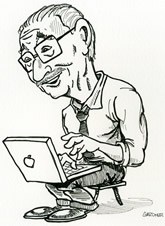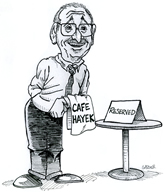But the data suggest that US businesses have absorbed most of the tariff costs through July 2025, not foreign sellers.
This blog post explores the effects of Trump’s tariffs on import prices for these five broad product categories to identify who has borne the costs so far. After all, the tariffs paid by the importers of record have to show up in one of three places: lower prices paid to foreign sellers, smaller spreads earned by US firms between the cost of imported goods and their selling prices, or higher prices paid by US households.
The US government has collected growing revenue from the tariffs paid by US importers, but the prices paid to foreign sellers for many imported consumer goods have changed very little. Meanwhile, American consumers have not yet seen much change in retail prices for most imported goods.
…..
Three scholars—Cavallo, Llamas, and Vazquez—have documented the short-term price behavior of thousands of individual retail items following the imposition of Trump’s tariffs. They found that average retail prices for imported items increased more than average retail prices for domestic items following tariffs imposed on March 4, 2025 (see their figure 2). Moreover, through August 2025, they found that retail prices of domestic items that were close substitutes to imported items increased almost as much as retail prices of imported items.
But there’s an important qualification. According to Cavallo et al., average retail prices for imported items were just 2 percent higher in August 2025 than in October 2024.
…..
However, the overall impact on the US Commerce Department’s price index for personal consumption expenditures (PCE) thus far remains limited. As of July 2025, the PCE price index had only increased by around 1.2 percent compared to January 2025. In other words, through the middle of 2025, American consumers were not bearing much of the tariff burden.
The logical conclusion is that, at least through July 2025, US firms were absorbing most of the tariff burden through compressed spreads between the cost of imported goods paid by the firms and the selling prices they received. Many firms probably based their selling prices on the historic cost of inventory imported prior to Trump’s tariffs, thereby delaying the impact on consumers.
Here’s the abstract of a forthcoming paper (in the California Law Review) by Kathleen Claussen and Timothy Meyer. The paper is titled “The Foreign Commerce Power”: (HT Scott Lincicome)
This Article is the first to scrutinize presidential trade authority under the Constitution. The Constitution grants the president no independent power to regulate foreign commerce. That conclusion, while apparent from a straightforward reading of Articles I and II, stands in stark contrast to executive conduct of U.S. trade policy in recent years. This Article traces the roots of this constitutional distortion to a confluence of doctrinal drift and academic oversight. Courts and commentators have increasingly relied on an expansive conception of executive power grounded in a perceived general foreign affairs authority. In doing so, they have blurred the line between diplomacy and commerce and used this confluence to justify unilateral economic actions by a “trader-in-chief” that circumvent the allocation of power in the Constitution. These matters have reached a tipping point over the last decade, prompting a series of high-profile cases in which the government has argued that this general foreign affairs powers include some portion of the foreign commerce power. To correct this misapprehension, the Article undertakes a novel examination of Founding-era materials, including the distribution of commercial authority between the king and parliament in eighteenth century Britain, the correspondence and deliberations of the Framers, and Founding Generation’s implementation of the commerce power in matters of national security during the early year of the Republic. These sources reveal a consistent and deliberate understanding both that Congress’s control over foreign commerce is exclusive and that Congress’s control over commerce trumps the president’s general foreign affairs powers when the two intersect. The Article further argues that this allocation was not accidental or ancillary, but central to the constitutional design. As the Supreme Court prepares to confront fundamental questions concerning the scope of executive trade authority, this Article provides the necessary historical and legal framework to restore the foreign commerce power to its constitutional home.
“Free speech means you can criticize anyone.”
President Trump is imposing a $100,000 fee to obtain an H‑1B visa, the primary visa for skilled foreign workers. To be clear, this $100,000 fee is in addition to the salary, lawyer fees, and other costs of hiring an H‑1B worker. This fee would effectively end the H‑1B visa category by making it prohibitive for most businesses to hire H‑1B workers. This would force leading technology companies out of the United States, reduce demand for US workers, reduce innovation, have severe second-ordereconomic effects, and lower the supply of goods and services in everything from IT and education to manufacturing and medicine.
Jim Geraghty contrasts an honorable, civilized spirit with a dishonorable, uncivilized one. A slice:
If you find turning the other cheek difficult, don’t worry. Someone else spoke at the Kirk memorial service to represent the other side, making the case for hate.
“He was a missionary with a noble spirit and a great, great purpose. He did not hate his opponents. He wanted the best for them,” President Donald Trump said. “That’s where I disagreed with Charlie. I hate my opponent. And I don’t want the best for them. I’m sorry.”
The crowd laughed.
“I am sorry, Erika. But now Erika can talk to me and the whole group, and maybe they can convince me that that’s not right. But I can’t stand my opponent. Charlie’s … angry at me … he wasn’t interested in demonizing anyone.”
Kevin Corcoran reveals “the social benefits of iconoclasts.”
Many critiques of US health care begin with the assumption that, as The Economist put it, the United States is “one of the only developed countries where health care is mostly left to the free market.” In truth, among wealthy nations, the United States may have one of the least-free health care markets—and it’s making health care less universal.
In a free market, the government would control 0 percent of health spending. Yet the Organization for Economic Cooperation and Development (OECD) reports that in the United States, the government controls 84 percent of health spending. That’s a larger share than in 27 out of 38 OECD-member nations, including the United Kingdom (83 percent) and Canada (73 percent), each of which has an explicitly socialized health care system. When it comes to government control of health spending, the United States is closer to communist Cuba (89 percent) than the average OECD nation (75 percent).



